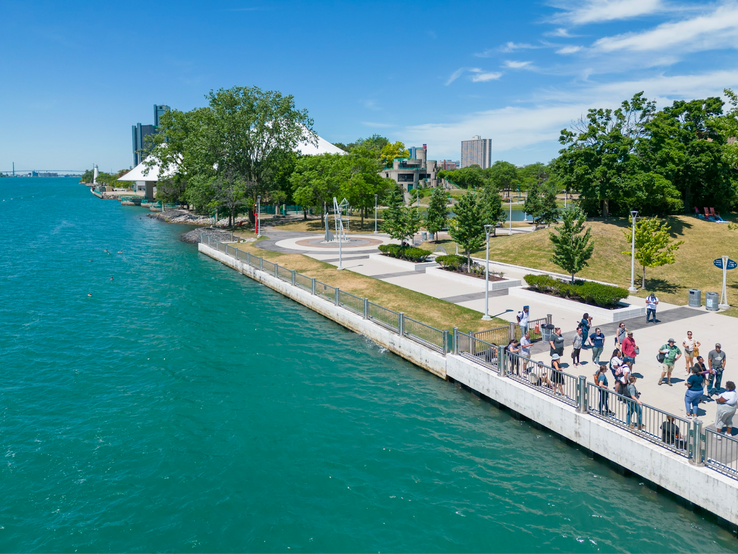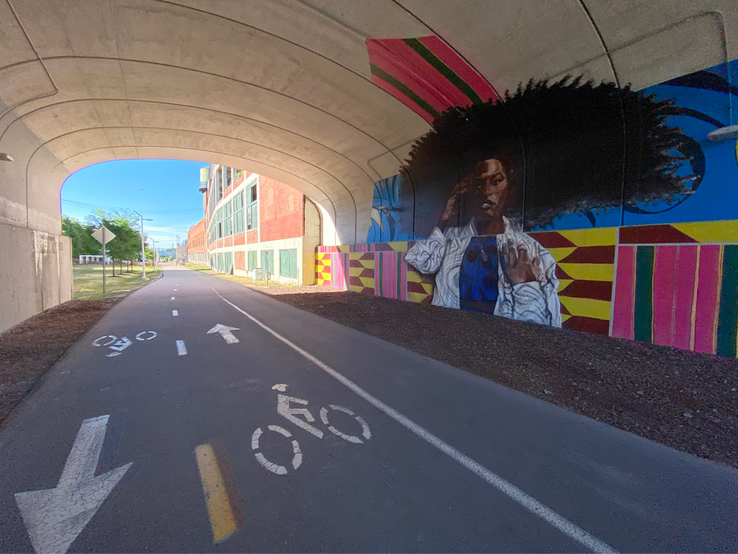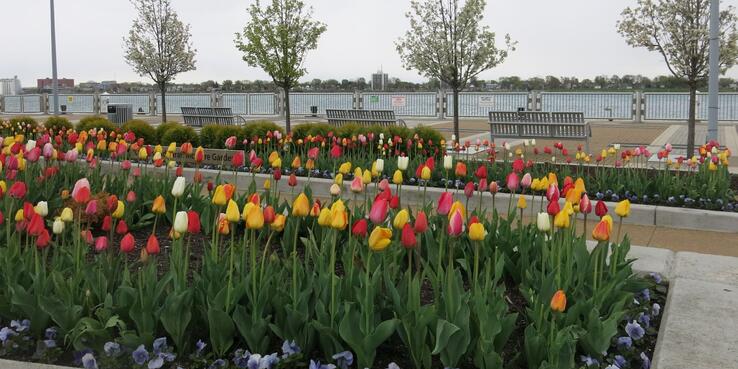Every year, SPUR takes a study trip to learn from other cities around the world. This spring we visited Detroit, a city that has long grappled with challenges the Bay Area now faces. We found much to admire in Detroit's focus on community-based interventions and recovery. See the bottom of this page for more articles about the trip.
The vision for the Detroit Riverfront Conservancy (DRFC) is simple: "Transform Detroit's international riverfront — the face of the city — into a beautiful, exciting, safe, accessible, world-class gathering place for all." Over the last 20 years, that vision has been fully realized, as SPUR’s study trip to Detroit in May confirmed.
For decades, the riverfront in Detroit was punctuated by run-down industrial sites, parking lots, and overgrown shrubbery and was mainly inaccessible to the public. In 2003, a group of local leaders from the Kresge Foundation, the City of Detroit, and General Motors formed the DRFC, with plans to collaboratively turn five and a half miles of riverfront property into a pedestrian-friendly walkway that would attract private and public interest in the space. From 2003 to 2014, the conservancy successfully transformed much of the waterfront into a beautifully landscaped, bicyclist- and pedestrian-friendly public area with parks, plazas, pavilions, and open green spaces.
The final phases of work, which began in 2015, are focused on transformation of the one-half-mile stretch from Gabriel Richard Park to the Ambassador Bridge. This stretch is the former site of a Uniroyal tire plant that closed in 1978. Once it is revitalized, the conservancy will have achieved its vision of three and a half miles of riverwalk along the East Riverfront, providing connectivity between riverfront parks and Belle Isle.
The transformation completed so far was accomplished with a $25 million grant from General Motors that covered the building of the GM Plaza and the first half-mile of the RiverWalk and a $50 million grant from the Kresge Foundation, its largest-ever single project grant. These two initial grants served as the economic catalyst to launch the conservancy's efforts and to attract significant funding from the public and private sectors.

Photo by Nadir Ali
The success of the DRFC’s fundraising efforts cannot be overstated. They attracted more than $1 billion dollars of public and private investment in the riverfront by 2013. As of 2023, that figure has doubled, and the conservancy has invested more than $200 million in revitalizing the Detroit Riverfront.
Can transformation of Detroit’s riverfront inform that of San José’s Guadalupe River Park? Emphatically, yes.
Before the DRFC was formed, a group of stakeholders evaluated visioning documents and past reports on the redevelopment potential of the Detroit Riverfront. The group also reviewed successful waterfront redevelopments to identify best practices for creating a revitalization strategy for the Detroit Riverfront.
Like the Detroit Riverfront, Guadalupe River Park (GRP) has been the subject of several reports and visioning documents. A reasonable move would be to convene a stakeholder group to do the difficult work of evaluating them all and culling lessons from successful riverfront projects like the Detroit Riverfront. On the basis of this research, the group would develop a comprehensive plan for realizing the GRP’s potential.
The DRFC’s strategy suggests several lessons for San José.
Lesson 1: Commit to cross-sector collaboration.
In forming the DRFC, stakeholders drafted a vision and signed an agreement outlining the concept of a cross-sector collaboration. The agreement established a commitment on the part of signatories to exert their utmost efforts to transform the vision into a tangible project. It fostered an awareness that fundraising activities and political will were essential for realization of the vision. The agreement allowed signatories to experience a sense of project ownership, and it conveyed a clear message to potential investors that the vision would indeed come to fruition. A vision and agreement to cross-sector collaboration will also be necessary to transform the Guadalupe River Park (GRP).
Lesson 2: Strive for stakeholder diversity.
The DRFC has worked hard to incorporate all relevant input from the community. The conservancy owes its sustainability in large part to stakeholder diversity. One-third of board members are women, and another third represent racial minorities.
Although the Guadalupe River Park Conservancy (GRPC) has an effective board, a broad stakeholder group that advocates for all the park’s users is needed. With so much of the current conversation about GRP relating to people experiencing homelessness, it's easy to overlook that many of the issues the park faces pre-date the influx of unhoused folks by many years. The notion that the park’s problems would be remedied if that population was no longer in the area is misguided. Instead, strategies that address the needs of the park itself should be considered while a realistic plan for serving the needs of unhoused people is developed.
Lesson 3: Plan for a long-term fundraising effort.
Despite Detroit’s well documented economic woes, the DRFC has never wavered in its dedication to pursuing funding to realize its vision of the Detroit Riverfront. Philanthropic organizations, corporate sponsors, and public entities all played crucial roles in providing the initial and ongoing funding for the project. The City of Detroit has provided financial resources and has collaborated on planning and development efforts. The State of Michigan has also allocated funds to support various phases of the riverfront revitalization project. Neither the DRFC nor the city could have pursued this project alone.
Transforming GRP will require the collaboration of the public, private, and philanthropic sectors and the identification of community and political champions.

Photo by Jason Su
Lesson 4: If possible, jumpstart redevelopment with one or more large investments.
The successful redevelopment of Detroit’s riverfront is difficult to imagine without initial massive investments from General Motors and the Kresge Foundation. Those investments signaled a commitment that attracted other funders. And they allowed much to be accomplished in a relatively short time, which also attracted funders.
Similarly large investments are needed to transform GRP. Piecemeal investments will never be sufficient to bring about significant improvements to a park as large and complex as GRP. A priority of the proposed GRP stakeholder group should be securing one or more multi-million dollar investments.
GRP has already benefited from redevelopment efforts, but its full potential has yet to be realized. The Detroit Riverfront should be an inspiration for its transformation, and the efforts of the DRFC, an example for achieving that transformation.
Read more coverage our our Detroit trip:
Making Detroit Home: Addressing the Challenges of Housing Stability and Habitability
How Detroit’s Food Entrepreneurs Are Invigorating Commercial Corridors and Neighborhoods
The Role of Public-Private Partnerships in Downtown Detroit's Revitalization
